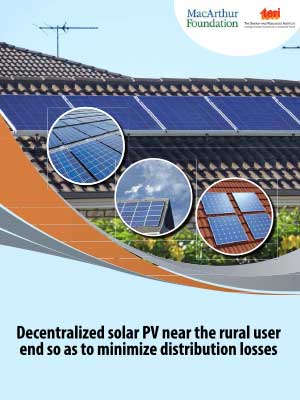Decentralized solar PV near the rural user end so as to minimize distribution losses
TERI with support from MacArthur Foundation released a project report during World Development Summit 2020 titled "Decentralized solar PV near the rural user end so as to minimize distribution losses" during the thematic session 'Managing Intermittency of Demand & Supply at Electricity Distribution-level at Gulmohar' for a study that looked at the operational aspect benefits of decentralised solar rooftops.

Under this study, two states were chosen, that is, Chhattisgarh and New Delhi; the former being a rural example with daytime loads not being high, while the latter is an urban example where daytime loads are quite significant. In Chhattisgarh, rural networks of the Chhattisgarh State Power Distribution Company Ltd (CSPDCL) were selected whereas BSES Rajdhani Power Ltd, Delhi (BRPL) in Delhi was chosen as a semi-urban feeder. The factors considered in identification of the selected networks were type of consumers, number of consumers, land availability, and grid availability. For rural substations in CSPDCL, Amlipadar, Gohrapadar, Deobhog, and Jhakharpara substations were selected, while for semi-urban feeders one West Delhi feeder of BRPL (referred as Network-1) was considered. As per the prevailing regulations, the allowed cumulative capacity limit of the solar power plants which can be set up is 70% and 45% of the distribution transformer rating, respectively, for CSPDCL and BRPL.
Based on the study, TERI has come up with the following recommended interventions to aid adoption of small-scale-distributed PV systems in distribution networks:
- While distribution transformers are technically capable of absorbing the PV power to 100% of their rating, there is a state-to-state variation on the PV capacity to be sanctioned on the distribution transformer. Hence, a uniformity is needed on PV capacity to be installed.
- At present for large centralised solar parks, the transmission and distribution charges are waived off, however this is not the case for small sized decentralised systems. It is therefore suggested that liberal tariffs are allowed for distributed solar systems.
- Different regions have different grid availability. In rural areas for instance, the study observed that grid availability was lesser during the day. This warrants for traditional design configuration of the solar PV system to be modified by considering grid availability. In case of semi-urban feeders, certain cases were observed during the study where solar PV was unable to bring the transformer loading below threshold limits during evening peak load conditions. Thus, there is a need to encourage the use of storage with solar systems.
- Currently, aggregate technical and commercial loss (ATC loss) is calculated by data obtained from meters at substation and loads. The decentralised system aid in reducing distribution loss. Hence there is a need to estimate the technical component of distribution loss to capture the benefits of the distributed PV systems.
- General awareness among DISCOM's field-level technical staffs on the impact of solar PV generation at tail-end grid is relatively low. There is a need for increased sensitization for the same.


